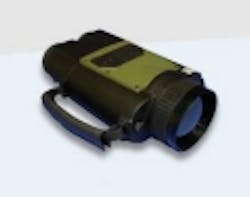From uncooled to cooled, FLIR sensor technology builds on soldier solutions
The two Recon M monocular systems, in two performance ranges, each weigh less than 14 ounces, have a 3-hour run time, and zoom to 4X while providing 500 meters of human detect range.
Recon M has a high-resolution, large-format long-wave VOx microbolometer that delivers range performance and image quality, as well as image and video options that enable the user to configure sensor to mission requirements.
FLIR’s STACE image enhancement technology provides image quality enhancements via spatial edge and dynamic range enhancement; auto gain and level control, which automatically provides optimized imagery; and multi-use capability so that it can be configured for handheld, tripod mount, or helmet mount.
The handheld sensors are part of a long-term FLIR strategy to develop soldier solutions that extend from long-range, cooled thermal and image intensified (I2) binoculars and sniper sights, to tactical sights that can be affixed to a range of weapon types.
“These soldier sensors are small—pocket scopes—that can be used for surveillance and reconnaissance," explains says Bill Sundermeier, president of FLIR Government Systems. "They will be inexpensive so that they will be accessible to individual soldiers and unit leaders. They’ll keep them in their pocket or velcro them to their web gear. They’ll be able to use them as a handheld night sight, and also clip them onto their weapon to use as a weapon sight.”
FLIR Systems has an advantage in the large volumes of detectors and optic devices the company manufactures. The majority of these detectors go into commercial industries like automotive, where standards for shock, vibration, and temperature far outstrip any mil-specs for thermal sensors.
“The two real cost components of an uncooled sensor are the detector and the optics, and we design and manufacture both of those inside our own company, so we have access to much lower cost components than anybody else,” Sundermeier says.
Over the past year, FLIR has offered cooled and uncooled thermal rifle sights, each of which has benefits and tradeoffs. The detector and the optics are the guts of the matter. Uncooled systems are inherently less sensitive, but potentially much lighter in weight with less power consumption than cooled systems.
To put it another way, cooled systems are for long-range performance, despite the added weight and power of a cryogenic detector cooler, due to their greater sensitivity and ability to use longer-range optics. Uncooled systems are better suited for shorter range applications where lightweight and low-power trump sensitivity considerations.
“Uncooled is better for short-range performance, in terms of those overall tradeoffs,” Sundermeier explains. “If what I’m doing is driving a vehicle down the road I don’t have to see far. But I do want a wide field of view. So for a sensor that needs a fairly wide field of view and a fairly short range performance, uncooled is great and also inexpensive enough to put on a vehicle.
“Conversely, if I really need to see a long way then I’m talking narrow fields of view and long focal lengths, and I really want to go cooled because my detector is so much more sensitive," Sundermeier continues. "I can live with these less sensitive optics and really reach out and touch somebody, and also package it in a reasonable size.”
Is it impossible to make a man-portable handheld cooled sensor or sniper sight? “Absolutely not,” Sundermeier says. “Products like our Recon III are available, which is cooled, has long battery life, long-range performance, and is light enough to be handheld, relative to other cooled systems."
For more information contact FLIR Systems online at www.flir.com.
